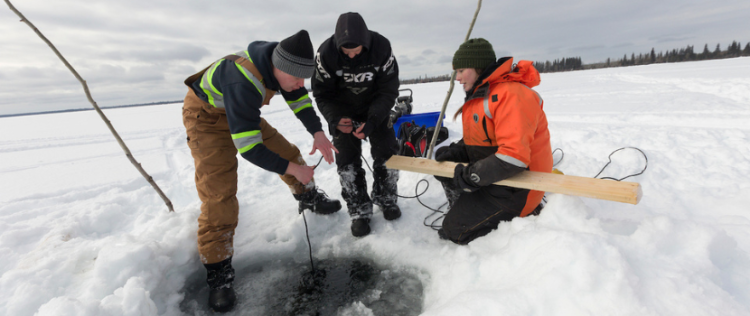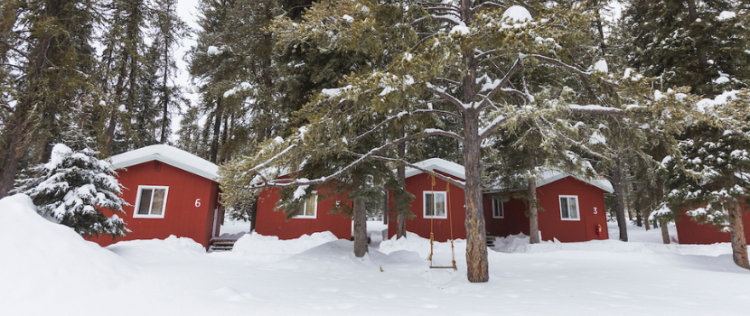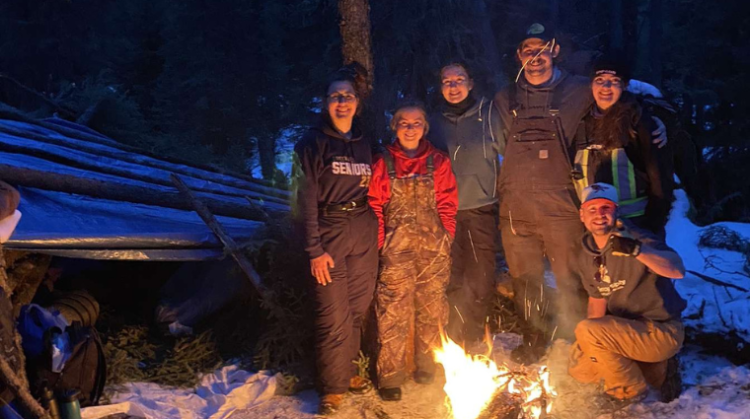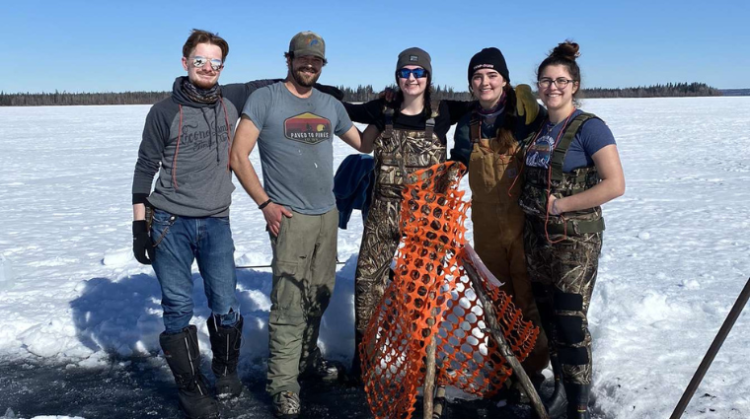
Image Credit: Saskatchewan Polytechnic
Each year in March, first-year Saskatchewan Polytechnic students in two natural resources programs participate in week-long winter camps at the Hannin Creek Education and Applied Research Centre (HCEARC) in northern Saskatchewan. Run in partnership with the Saskatchewan Wildlife Federation and located on the shores of Candle Lake, the facility is an ideal spot to experience both the beauty and extremes of a Canadian winter.
The camps give students in the Integrated Resource Management (IRM) and Resource and Environmental Law (REL) programs a one-week, intensive outdoor experience and the opportunity to put classroom learning into practice. Instructor Rebecca Perry, who leads part of the camps, explains that the experience teaches both science curriculum and outdoor education skills such as winter survival. "It's a great way for us to bring program learning from our first semester to a real-world environment," she says, noting that each day is packed with experiences ranging from snowmobile use to aquatic science.
Right on day one, students take an SGI-accredited course on snowmobile use and maintenance and once trained, are off on the sleds for fisheries exercises on the lake. "These go hand-in-hand," says Perry, who is herself a fish ecologist. "You can't do fish ecology if you can't get to where the fish are and in Saskatchewan in winter, that means a snowmobile."
Out on the lake students learn how to set nets under the ice according to standard fisheries sampling protocols. The students then process the fish for important biological information such as size, sex, age and the presence of parasites and disease. Some of this learning is completed onsite, however students also prepare samples to take back to Prince Albert campus for further lab work. "We also teach water quality testing while out on the ice to look at dissolved oxygen levels and whether they are sufficient for fish," explains Perry.
"Setting the nets was an interesting challenge," says REL camp participant Jarret Cossette. "We drilled entry holes, then floated wood planks attached to ropes under the ice about 30 feet before drilling exit holes. We then fed nets back on the rope and waited. The next morning, all the groups pulled up a fish or two and we were able to complete a long anatomy lab where we dissected and learned more about them."

Image Credit: Saskatchewan Polytechnic
"The hands-on learning throughout the camp was extremely beneficial," says IRM student Daxton Ursu. "Out on the land we learned from trial and error. A video or slide presentation can teach you a lot, but it can't show you what handling a fish feels like."
Back at camp, students were able to warm up and complete further work on their samples. HCEARC has a newly built lab and classrooms space with long benches and sinks. "It's an excellent blend of rustic and modern," says second-year IRM student Courtney Cherpin, who took part in the camp in her first year last March. "It feels like a camp, but it has new space for teaching and learning. Oh, and new bathrooms. There's nothing quite like a hot shower at winter camp!"

Image Credit: Saskatchewan Polytechnic
This year's two cohorts of students had distinctly different experiences, with the IRM students attending camp the first week of March and the REL students attending the second week. This year's March snowfall ensured that both cohorts got the full winter camp experience, though the first group had significantly colder weather than the second.
Seasonal weather no matter how cold is perfect for day two, where instructors teach winter survival skills. Prior to camp, students are given theory on survival techniques but, says Jim Bahr, the instructor who teaches this portion of camp curriculum, there is really no substitute for the real thing when it comes to survival skills. "We send the students out in the morning with limited equipment. They build shelters in small groups and collect enough firewood to be able to stay out for the night. This way, students experience what it would be like to be stuck out in the winter in an emergency, but in a safe environment where we can check that they have built a secure shelter that will keep them safe and warm. I make the rounds three time in the night to check on everyone."
"My favourite part of winter camp was shelter building, then sleeping in it with three of my classmates," remembers Cherpin. On campus, we all go our separate ways at the end of the day. At camp, I really got to know people. It was a bonding experience to wake up to extreme, sub-zero temperatures. We were warm, though. We built a good shelter."

Image Credit: Saskatchewan Polytechnic
This year's students also cite shelter-building as a camp highlight. "My group worked really well together," says first year REL student Lexi Hershmiller. "We used a couple standing trees to support a wall of logs, then used a triangle of branches overtop to support a tarp. I had a better night's sleep in our structure than I did in the cabin. Admittedly, it only got down to zero. We won the warm-week lottery!"
Brynn Grimard, an IRM student who attended the first week's camp, says the shelter she and her group of three other women built helped them withstand a night that went down to -28 degrees. "I had a nice warm sleeping bag, and we used aluminum space blankets on top of our spruce bough bed to reflect heat from the fire," she says. Ursu jokes that his group's shelter, which, like Grimard's, was liberally lined with space blankets, was sponsored by NASA.
Cossette enjoyed the night spent under the stars but adds that camp food was also a highlight: "Thanks to the two women who run the camp kitchen the whole week is really much more like glamping' than camping. They are amazing cooks and I was always excited for the next meal."

Image Credit: Saskatchewan Polytechnic
Great meals help support a busy week with long days of learning. The students don't seem to mind the extended schedule and are eager to spend as many hours as possible out on the land among mature jack pines and wildlife, including foxes, grey jays and grouse. "Being outdoors is such a highlight of the camp, and my program overall," says Grimard.
"Winter camp is a really important aspect of our program," agrees Hershmiller. "It's very hands on, and people who go into this kind of program are typically the hands-on type. At Hannin Creek, we get a better understanding of what people working in the field do and why. It's an interactive experience and beneficial because it gets you out there doing the actual activities you will do in your work."
"It's also a great bonding experience," Hershmiller adds. "Your classmates are your future coworkers and confidants, and learning to work with them is important." Ursu agrees, saying, "It gave us a chance to talk to and learn from each other."
This year's winter campers have a three-week Fall camp to look forward to in their second year, something Cherpin has already experienced. Now nearing the end of her program, she plans to work in fisheries upon graduation and has a job lined up with the Saskatchewan Water Security Agency. "Integrated Resource Management can lead to a huge range of jobs," says the student, who is curious to see where her classmates end up. "We do something like 30 classes over the two years, ranging from wildlife and fisheries management to wilderness survival, forestry and fire management oh, and technical report writing. We really have covered a lot."
Camp is a program highlight for both students and instructors in the two programs. "Getting out in the bush and actually practicing the skills we're teaching and that students are learning that's special," says Perry. "It's where I get to really share my passion, and I love to see the spark in students when they do something for the first time in the field."

Image Credit: Saskatchewan Polytechnic
Learn more about the Integrated Resource Management (saskpolytech.ca) and Resource and Environmental Law (saskpolytech.ca) programs.
Many full-time programs still have available seats for fall 2024. Find a program and apply today.
Saskatchewan Polytechnic is signatory to the SDG Accord. Sustainable Development Goal alignment is one of the ways Sask Polytech is leading the rise of polytechnic education.











